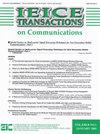Power Allocation with QoS and Max-Min Fairness Constraints for Downlink MIMO-NOMA System
IF 0.6
4区 计算机科学
Q4 ENGINEERING, ELECTRICAL & ELECTRONIC
引用次数: 0
Abstract
SUMMARY Non-orthogonal multipe access based multiple-input multiple-output system (MIMO-NOMA) has been widely used in improving user’s achievable rate of millimeter wave (mmWave) communication. To meet different requirements of each user in multi-user beams, this paper proposes a power allocation algorithm to satisfy the quality of service (QoS) of head user while maximizing the minimum rate of edge users from the perspective of max-min fairness. Suppose that the user who is closest to the base station (BS) is the head user and the other users are the edge users in each beam in this paper. Then, an optimization problem model of max-min fairness criterion is developed under the constraints of users’ minimum rate requirements and the total transmitting power of the BS. The bisection method and Karush-Kuhn-Tucher (KKT) conditions are used to solve this complex non-convex problem, and simulation results show that both the minimum achievable rates of edge users and the average rate of all users are greatly improved significantly compared with the traditional MIMO-NOMA, which only consider max-min fairness of users.基于QoS和最大最小公平性约束的下行MIMO-NOMA系统功率分配
基于非正交多路接入的多输入多输出系统(MIMO-NOMA)在提高毫米波通信用户可达速率方面得到了广泛的应用。为了满足多用户波束中每个用户的不同需求,本文从最大最小公平性的角度出发,提出了一种既满足头部用户的服务质量(QoS),又使边缘用户的最小速率最大化的功率分配算法。假设在每个波束中,距离基站最近的用户为头部用户,其他用户为边缘用户。然后,在用户最小速率要求和基站总发射功率约束下,建立了最大-最小公平性准则的优化问题模型。采用对分法和kush - kuhn - tucher (KKT)条件求解这一复杂的非凸问题,仿真结果表明,与仅考虑用户最大-最小公平性的传统MIMO-NOMA相比,边缘用户的最小可达率和所有用户的平均率都有了显著提高。
本文章由计算机程序翻译,如有差异,请以英文原文为准。
求助全文
约1分钟内获得全文
求助全文
来源期刊

IEICE Transactions on Communications
工程技术-电信学
CiteScore
1.40
自引率
28.60%
发文量
101
审稿时长
3.7 months
期刊介绍:
The IEICE Transactions on Communications is an all-electronic journal published occasionally by the Institute of Electronics, Information and Communication Engineers (IEICE) and edited by the Communications Society in IEICE. The IEICE Transactions on Communications publishes original, peer-reviewed papers that embrace the entire field of communications, including:
- Fundamental Theories for Communications
- Energy in Electronics Communications
- Transmission Systems and Transmission Equipment for Communications
- Optical Fiber for Communications
- Fiber-Optic Transmission for Communications
- Network System
- Network
- Internet
- Network Management/Operation
- Antennas and Propagation
- Electromagnetic Compatibility (EMC)
- Wireless Communication Technologies
- Terrestrial Wireless Communication/Broadcasting Technologies
- Satellite Communications
- Sensing
- Navigation, Guidance and Control Systems
- Space Utilization Systems for Communications
- Multimedia Systems for Communication
 求助内容:
求助内容: 应助结果提醒方式:
应助结果提醒方式:


